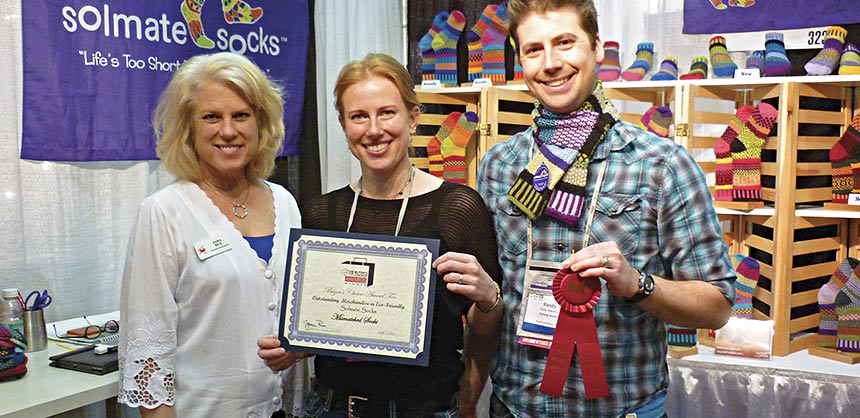Show and TellFebruary 1, 2014
Planners Reveal Their Exhibitor Retention Tactics By Derek ReveronShow and Tell
Planners Reveal Their Exhibitor Retention Tactics
Jama Rice, MBA, CAE, Executive Director/CEO of the Museum Store Association, with Buyer’s Choice Award-winners from Solmate Socks at the 2013 MSA Expo in Los Angeles. The awards, voted on by attendees, give special recognition to exhibiting companies with the most innovative products. Credit: MSA
“Show and tell” brings to mind kindergarteners standing in front of the class proudly expounding on their most prized possessions. For association meeting and convention planners, a calculated exhibitor “show and tell” strategy is necessary to keep their most prized “possessions” coming back year after year.
Exhibitors, after all, are the financial lifeblood of associations, providing funds for member benefits and activities. But the fragile economy has exhibitors trimming their trade show budgets — and perhaps reallocating larger slices of marketing budgets to online advertising. So the pressure is on for planners to justify participation by proving return on investment; and to nurture exhibitor relationships before, during and after the show. It’s a crucial challenge, as it costs less time and money to keep exhibitors than to acquire new ones.
That’s why organizations such as the Museum Store Association (MSA), whose members include museum store professionals and their vendors, are redoubling efforts to retain their exhibitors.
While the MSA hasn’t significantly increased its number of exhibitors over the last few years, the organization has attracted 250 to 260 exhibitors to each of its annual conferences during that time. “That, to us, is a bit of a success story in this economy because of the economic challenges our members face and the market we are in,” says Jama Rice, MBA, CAE, executive director/CEO of the MSA. She is especially proud of the number of long-time exhibitors. Nearly 40 exhibitors have attended the conference for at least 14 out of the last 15 years.
The MSA’s success stems from ongoing exhibitor retention efforts. For example, the MSA is in the process of rolling out a new exhibitor services program. Previously, exhibitors contacted various MSA officials and third-party vendors for MSA services such as exhibit sales; advertising in the organization’s magazine and on its website and newsletter; and sponsorships and proprietary online product directory. The new program provides one point of contact within the MSA for all services.








